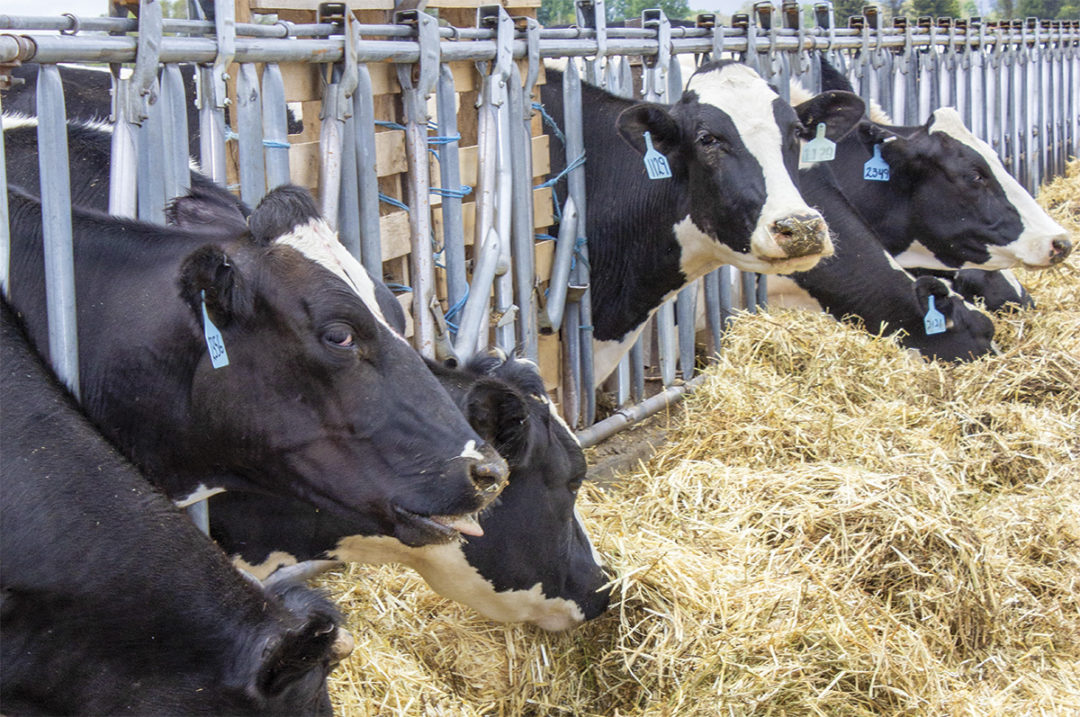Calving is not a disease; it is a stage that needs to be managed and how that is done will impact a cow for her entire lactation. Best practices for transitioning a cow from far-off fresh to her lactation group has a host of areas that require focused attention by the entire management team on the dairy. A veterinarian panel of Dr. Greg Crosley of Countryside Veterinary Clinic, Dr. Rachelle Bennecke of Stoney Hills Veterinary Service and Dr. Mark Fox of Thumb Veterinary Services offered their practical expertise to the attendees of the Great Lakes Regional Dairy Conference held recently in Mt. Pleasant, Michigan.
“Broken fresh cows are costly to the dairy, and whenever we see that, we need to go upstream and see what’s happening beginning with dry-off day,” Fox began as he questioned Crosley and Bennecke.
There are some very basic moves to be made to keep dry cows in good shape until they freshen.
“Making sure the pen isn’t overcrowded is important,” Crosley said. “We have figured out how to feed these cows, but when they are crowded at the bunk, that’s when we see lots of problems.”
“The dry cows are often forgotten about. We put them somewhere out of the way and forget about them,” Bennecke said. “We had a herd that had a significant number of [displaced abomasums] in the first 20 days of lactation, and one of the things we went back to fix was the far-off dry cows. They were overcrowded, they weren’t putting sand in frequently enough, they weren’t cleaning the pens often enough and they weren’t pushing up the feed often enough. They were left to their own devices, and when we fixed some of those obvious problems, it made a huge difference once they were fresh.”
The dry-cow ration also makes a difference as Fox pointed to low-energy diets that “just flat work here in Michigan.” He said the Midwest is turning to straw diets that are working well for dry cows, especially if the straw is processed and the right amount of water is added to it.
The close-up cows
The welfare of pre-fresh cows is critical according to Crosley.
“They should have lots of bunk space, and in fact, if someone was going to invest in their dairy, this would be a great place to do it,” Crosley said. “Some think that the transition in diet is the problem with fresh cows, but it’s usually not. When they come from a good, low-energy diet and are not crowded, that seems to work better.”
Good ventilation is also key for pre-fresh cows, and the way dry cows are handled is also important.
“Cow handling in the pre-fresh group is sometimes even more important than with fresh cows,” Bennecke said. “Be as calm as possible around these cows.”
Group calving
In his years as a practicing veterinarian, Crosley has seen a lot with the calving process and remarked that he has not witnessed much group calving yet – most of his farms use a calving pen. He went on to describe a sled device put behind a cow when she is calving in the freestalls.
“To be honest, if you look at the percentage of problems in those herds versus the ones we move into a calving pen, it’s considerably lower,” Crosley said.
He pointed out that it could be a situation where the social order is not disturbed and therefore the cattle do better.
Management of the group calving pen is another major consideration.
“Managing the bedding is a full-time job,” Bennecke said. “It’s great for the stress level of the cattle, but management is a lot.”
Placing cattle in individual calving pens is also an option, but Fox said, “While those make sense, cows don’t like being in those pens by themselves for long periods of time. And the calving pen should be one of the quietest places on the dairy farm.”
At calving time
The timing of protocols around calving is important. Employees need to know when to hold back and when to assist the cow.
“Training on timing is very important,” Crosley said. “If we say there are too many DOAs [dead on arrival], then people feel pressure to go in [and] pull calves, and most of the time that happens prematurely. Adequate training and helping them understand the physiology of calving helps people make better decisions.”
Monthly parameters posted for employees can be a beneficial tool, and Bennecke said he has seen farms use this successfully. “They have it broken down into categories like DOA rates, metritis rates for the cows and calf sickness rates. These are all objective things that the employees can examine and see where they are trending, and it’s a measure of what kind of job they are doing.”
Beef-on-dairy crosses have delivered bigger calves in many cases, and while employees can get in a hurry when they see a cow that needs assistance, Bennecke said it is important to remember the same principles apply as with normal calving.
“We have to take our time, use good lubrication and keep everything clean,” Bennecke said. “It’s important to keep in mind that what we do on that day, in that hour of calving, has a significant impact on a cow for her entire lactation.”
Colostrum collection
With collecting colostrum, Crosley remarked, “There are a lot of ways to skin a cat, but it’s important to keep track of the colostrum and not use it if it gets too old. Frozen colostrum lacks the white blood cells that can be very helpful in setting the caf up in preventing disease.”
Fox added, “There is a pot of gold in colostrum and the more volume of milk there is, the quality decreases.”
Both Crosley and Bennecke said they believe the sooner a cow is moved into her lactation group, the better. Crosley said that moving her right away has social benefits, and he thinks they consume more dry matter.
The use of AI
The use of artificial intelligence (AI) in large dairy herds is an adopted trend. Collars can provide data that are useful to every dairy producer. But how useful are they?
“What we thought we knew is not what we knew,” Crosley said. “We must look at a cow’s trends over a couple of days before we decide if there is a problem. But the very best measure is milk production. Her temp can go up and down and her rumination can go up and down, but when milk production goes down, that is a cow we need to be looking at.”
“Years ago, we thought we had to temp every cow or give a magic bolus to every cow,” Bennecke said. “I’m hoping these AI systems will take us away from excessive treatments that we were doing because we wanted to get ahead of something that may not have ever been a problem. Personal observation of the herd on a daily basis is very important as well.”
It's the people
When it comes down to it, Crosley believes it’s the people that make the difference on-farm. “Of all the things I can do on a farm, the one thing I would like to do is to train the people to do a good job,” Crosley said. “In the end, it will be the people who will make the farm do well. So, training them and encouraging them and letting them know they are appreciated and respected is most important.”







